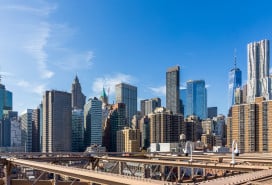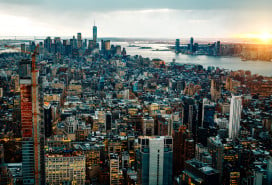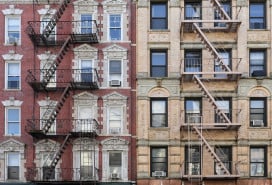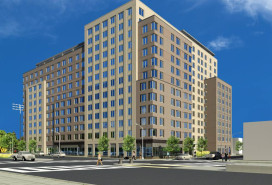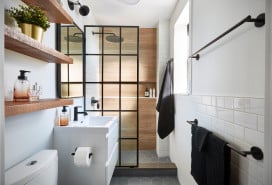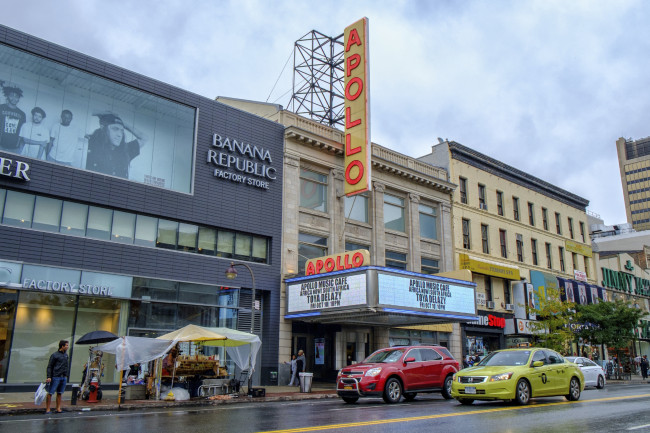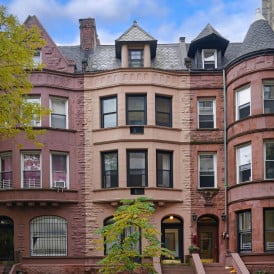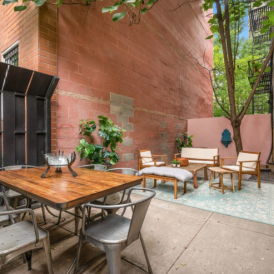NYC pride: Tracing the history of New York's LGBTQ neighborhoods from past to present
Last June, President Obama designated the Stonewall Inn a national monument, in recognition of the evening in 1969 when the gay bar’s patrons rose up against a police raid, an act of resistance that kick-started the LGBT civil rights movement. The official recognition is significant, but also worth noting is the far-reaching influence of LGBT communities on New York City and its neighborhoods, predating the Stonewall riots by many years. Greenwich Village is now widely considered the birthplace of the LGBT civil rights movement; other areas, including Harlem, Chelsea, and Hell's Kitchen, have developed over time their own distinct identities that are inextricably linked to LGBT people who lived there.
[Note: This post first ran in June 2016, and was updated in June 2017.]
But today, the LGBT population is becoming more diffuse in these places. Amin Ghaziani, a sociology professor at the University of British Columbia, sees statistician Nate Silver as an example of what he calls a "post-gay" identity, in which one's sexuality plays less of a role in major choices like where to live. (In an interview with Out Magazine, Silver said he considers himself to be sexually gay, but "ethnically straight.")
"Many sexual minorities now perceive themselves as culturally similar to heterosexuals, and heterosexuals say they don't care about a person's sexuality anymore," Ghaziani observes. "That mindset affects the decision that people make about where they want to live. Many more parts of the city will feel viable to them."
In a 2014 study, "Exploring the Gay Community Question: Neighborhood and Network Influences on the Experience of Community Among Gay Men," the authors note that "gay enclaves have served as important sources of social support, solidarity, and network building for members of the gay community, especially so for those who have experienced a sense of rejection by their natal communities." Does an atmosphere of broader increased tolerance, then, also meaning losing centers for building a sense of community? And what does that loss mean for places like Greenwich Village that are so rich in LGBT history?
The history of LGBT people in the Village
“The Village has been a center of LGBT life since at least the late 19th century,” says Andrew Berman, executive director of the Greenwich Village Society for Historic Preservation. And just in time for this year's pride celebrations, the GVSHP has expanded its Civil Rights and Social Justice map to reflect many of the sites in the Village that are most significant to LGBT history.
A look at the map reveals how as early as the 1890s, there were neighborhood businesses associated with “gay male society." The Slide at 107 MacDougal, for instance, was known as a "fairy resort" and a place where gay men could meet; it was shut down by police in 1892, two years after opening. And the Black Rabbit, at 183 Bleecker, hosted live sex shows in the 1890s before it, too, was raided by police in 1899 for its “depths of vice.”
In addition to offering risque entertainment, the Village served as a bastion of tolerance and progressive causes throughout the 20th century. “The Village has always been on the leading edge of social, artistic, cultural, and political movements,” Berman says. “And LGBT people have been a big part of it.”
By the end of World War I, the Village, with its then-ample affordable housing stock, had become a haven for creative people of every stripe. There were multiple eateries, bars, and cafes where gay men and women were welcome, and though these places were also targets for police raids, many thrived. The GVSHP map highlights, for example, Eve Addams Tea Room at 129 MacDougal, opened in 1925 as a place where "ladies prefer each other."
Berman notes that even by the mid-century, when many urbanites were fleeing for the suburbs, the Village held tremendous appeal. “The flight to the suburbs never had the same draw for gay people, because much of what they needed to connect couldn’t happen there,” he says. “Whereas they could connect in places like the Village.”
No wonder, then, that it drew such LGBT icons as James Baldwin, who lived on Horatio Street from 1958 to 1963, and Allen Ginsberg, who made the East Village his home in 1952 and remained there until his death in 1997.
In 1966, a major act of resistance unfolded at Julius’, a bar on West 10th Street. Members of the Mattachine Society, one of the nation’s first gay rights organizations, held a “sip-in” there in protest of laws against serving alcohol to homosexuals. (Read more about it at Next Magazine.) Just three years later, on June 28, 1969, the Stonewall riots sparked a fully-fledged civil rights movement.
The ensuing decades were transformative for LGBT people--as well as for how they were perceived by the country at large--with advocacy organizations and cultural centers blossoming throughout the Village. In 1973, for instance, PFLAG was founded at the Church of the Village; the first LGBT Jewish synagogue opened on Bethune Street that same year. In 1985, the Harvey Milk High School, the first public school intended to serve LGBT youth, was established at Astor Place, and Judson Memorial Church provided much-needed support to runaway teens, and later, to people with HIV and AIDS, during the 1970s and 80s. (For more, see the GVSHP map.)
Are gay neighborhoods like the Village now vanishing?
The import of the LGBT community in New York is unmistakable, but today some worry that neighborhoods like the Village are losing their identities as gay enclaves. In 2014, Amin Ghaziani published There Goes the Gayborhood?, an investigation of what he calls “post-gay” life, in which gay populations are becoming less concentrated in specific areas, due to both economic and cultural factors.
“Despite the myth of gay affluence, LGBT people are more likely to be poor,” Ghaziani says. He cites the statistic that 11.9 percent of same-sex households are living at the poverty line, versus 5.7 percent of married heterosexual households. At the same time, the very presence of LGBT people is correlated with rising costs. “The gayer the block, the faster its value will rise,” Ghaziani says. And since straight people always outnumber LGBT people, when housing becomes more expensive, “it’s not sustainable [as a gayborhood] unless gay people never move out.”
Meanwhile, tolerance of LGBT people has increased significantly. “Gay neighborhoods are a spatial response to a historically significant form of oppression,” Ghaziani says. He explains that many gay neighborhoods were solidified in the wake of World War II: After members of military were discharged on the basis of their sexuality, they decided to stay behind in major port cities, leading to the emergence of areas like the Castro in San Francisco as well as the Village.
“When the political status of a minority group changes, so too should its spatial response,” Ghaziani says. “It would be naive of us to deny that the condition of life for at least a segment of non-heterosexuals today is considerably better than it was in generations past. We’re moving beyond the closet”—and out of former gay enclaves.
Of course, homophobia has not been eradicated, which the 2016 massacre at the Pulse nightclub in Orlando made tragically clear; it also reveals the continuing need for places of sanctuary in a world that isn't as safe for LGBT people as it is for straight ones. (According to the Trevor Project, LGBT youth are four times more likely than their straight peers to attempt suicide.)
That said, Berman agrees that the Village has definitely become less gay. “The neighborhood has become so expensive that only a certain strata of people can afford to move in there,” he says. “Other neighborhoods have probably supplanted the Village in terms of LGBT residents.”
Berman cites Chelsea and Hell’s Kitchen as two places that grew into gayborhoods in their own right; per the Huffington Post, the 2010 Census found that indeed, these areas have the highest population of same-sex couples. “But the Village is now an internationally recognized center of a worldwide movement, and its place in that history is not fading,” Berman continues. “It’s where LGBT and non-LGBT people can go to see this important place that helped nurture and launch a movement, which has had such an impact.”
And Ghaziani says it’s a mistake to think of cities as comprising discrete gay and straight areas. “Plurality is the name of the game now, and there are multiple pockets associated with gay sexuality,” he says. “Economic and cultural trends enable gay neighborhoods to survive despite the reality of residential change, as places for people to remember their history and participate in the unique and beautiful culture of LGBT individuals.”
Brian C. Kelly, a sociology professor at Purdue University and an author of the "Exploring the Gay Community Question" study, agrees with Ghaziani that societal changes in recent decades have facilitated greater freedom in where LGBT people can live. He adds, though, that the increase in safe residential options in New York may not be mirrored throughout the country. "If we do this work in a smaller midwestern city, we might find something very different than what we're seeing in this large northeastern city with a long history of folks migrating from other places, because of the freedoms that people have enjoyed here," he says. "It's not clear to us yet whether major cities like New York are exceptional in some way."
Preserving important places in LGBT history
That said, there are areas of the city in which LGBT influences may have been overlooked: The Village certainly looms large, but LGBT men and women have left legacies throughout all five boroughs. One organization that is paying tribute to their impact is the NYC LGBT Historic Sites Project. Ken Lustbader is co-director of the project, a digital exploration of places of importance in New York’s LGBT past. He notes that while sites like Stonewall are known internationally, there are many more spots worth honoring for their significance.
“Our main goal is to document history and make it visible,” Lustbader says, describing the development of an interactive site in which visitors can click around and explore moments in the city’s LGBT past, beginning in the early 1800s through 2000. The project’s other aim is to identify places that meet the threshold to be added to the National Register of Historic Places, which as of today includes only ten sites listed specifically for their LGBT associations.
The places listed on the Historic Sites Project range from the house in Brooklyn where Walt Whitman lived while finishing Leaves of Grass in 1855, to the Jackson Heights street corner where Julio Rivera was murdered in 1990 for being gay, prompting Queens’ LGBT community to organize in response. Lustbader observes that another of the sites, the Alice Austen House, has already been added to the National Register of Historic Places for the work of its pioneering owner, a photographer, artist, and athlete—but nowhere in the registry information does it include that Austen lived there for 50 years with her female partner.
Lustbader says that in a way, “probably every neighborhood of New York was gay, because there were gay people living there. Gay people populated New York City way before Stonewall.”
Ghaziani agrees that it’s a mistake to see the city through a binary lens. At the same time, despite the diffusion of LGBT communities, people still find a way to unite. “In the aftermath of the Orlando massacre, we see a tremendous amount of power that inheres in neighborhoods to bring together a community, facilitate political mobilization, and catalyze change,” he says.
You Might Also Like


